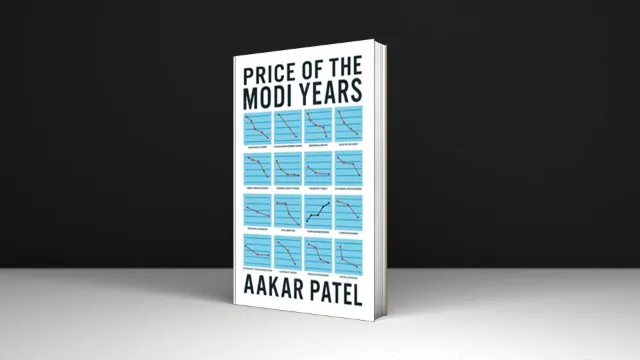Aakar Patel, former head of Amnesty International in India, has savaged the seven years of Narendra Modi\’s rule in his latest book, Price of the Modi Years. Backed by considerable research, it has more credibility than other rhetorical denunciations of BJP rule.
The book has a clever cover of 16 charts of India\’s performance measured by international indices. India shows a downward trend in 15 indices and improvement in only one – the Doing Business Index of the World Bank, which the Bank itself has abandoned as fatally flawed.
Patel argues that the Modi years have been about slogans, not performance. He grants Modi has changed the discourse of the idea of India, made communalism respectable and put secularism on the defensive. Patel thinks Modi has failed badly on economic, governance and external affairs, but used communalism and jingoism to attain formidable popularity. There is much truth in this, but Patel too easily dismisses Modi\’s achievements in welfare and financial inclusion. Modi may have stolen many Congress policies and renamed them (such as Swachh Bharat and Jan Dhan Yojana), but has implemented them so much better than Congress that he merits the credit for it.
In a chapter titled Brand versus Product, Patel lists 58 different international indices compiled by reputed global institutions. India has improved its position on just four and fallen or performed badly in the other 54. It is worth listing some; there is no space for all.
The Economist Intelligence Unit\’s Democracy Index looking at civil liberties, pluralism, political culture and participation: India has fallen from 27th rank in 2014 to 53rd in 2020.
Pew Religious Restrictions rating: In social hostility, India has worsened from 9.0 to 9.6, and in religious restrictions, from 5.0 to 5.9.
Lowy Institute Asia Power Index: Score fell from 41.5 in 2018 to 39.7 in 2020, below the threshold of 40 needed for \’major power\’ status.
IMD World Competitiveness Ranking: India slipped from 40th position in 2013 to 43rd in 2021. Note that it was in 27th position in 2007 and so fell faster under UPA.
Freedom House\’s Freedom in the World Index: India fell by 10 positions between 2015 and 2020. Its status changed from \’free\’ to \’partly free\’.
World Press Freedom Index: Fell marginally from 140th in 2012 to 142nd in 2021. Its position was dismal even under the UPA.
Fraser Institute\’s Global Economic Freedom Index: India\’s ranking fell from 95th in 2015 to 105th in 2020.
Cato Human Freedom Index: India fell from 75th in 2015 to 111th in 2020 on issues such as rule of law, religious freedom, civil liberties and economic freedom.
Fund for Peace\’s Fragile States Index, measuring social cohesion and allied matters: India fell 15 places between 2014 and 2021.
IFPRI\’s Global Hunger Index: India fell from 55th of 76 nations in 2014 to 94th of 107 nations in 2020. India has fallen behind even Pakistan, Bangladesh and Nepal.
Coursera Global Skills Report: Between 2019 and 2021, India fell from 50th to 55th position in business skills, from 44th to 65th in technological skills, and from 51st to 66th in data science skills.
Transparency International Global Corruption Perceptions Index: India is down marginally from 85th in 2014 to 86th in 2020. However, this hides that India\’s rank improved in between to 78th in 2018.
Critics may charge Patel with cherry-picking the beginning and end dates of international comparisons to exaggerate Modi\’s failures. He may also have left out some indices showing India in a better light. Nevertheless, his list is a formidable indictment.
He is at his best in elucidating the harassment of minorities and the alienation and violation of civil rights in Kashmir. He gives sobering examples of how the judiciary that once checked human rights violations has become complicit, above all, in Kashmir.
He is less convincing in denouncing economic performance. Modi\’s first five years (2014-19) were pretty good. Growth then dipped sharply, even before Covid. But was that a blip or new trend? The IMF predicts 9.5% growth for India in 2021 and 8.5% in 2022, the fastest in the world. Patel ignores soaring achievements in renewable energy and startups. The jury is still out on economic performance.
Patel claims passenger vehicles sales stagnated at 27 lakh from 2012 to 2020. Sorry, but the Society of Indian Automobile Manufacturers (SIAM) says that sales of passenger vehicles (cars, vans and utility vehicles) were 26.86 lakh in 2012-13, rose steadily to 33.77 lakh in 2018-19, then collapsed to 27 lakh the next year. Six good years followed by a bad year and Covid looks more a blip than stagnation.
Nevertheless, Patel has done an excellent job exposing the crash in India\’s international stature in religious freedom and human rights. Even a sharp economic recovery will be scant consolation for that. What profits a man if he gains the whole world but loses his soul?
This article was originally published in The Economic Times on Jan 11, 2022.


